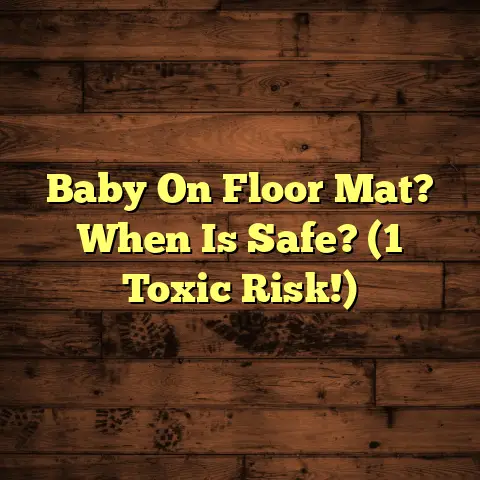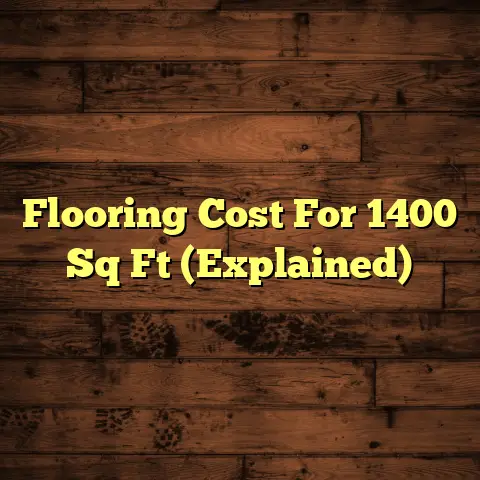Fixing Ply to Concrete Floor? (1 Day Fix!)
For years, I’ve seen folks shy away from tackling plywood-to-concrete projects, thinking it’s some kind of advanced black magic only pros can handle.
“It’s too complicated!” they cry. “It’ll take forever!”
Well, I’m here to tell you that’s a load of baloney!
With the right know-how and a bit of elbow grease, you can absolutely nail this project in a single day.
Seriously! Let’s ditch the myth that this is some herculean task and dive into how you can conquer that concrete with plywood like a seasoned pro.
Section 1: Understanding the Basics
So, why even bother with plywood on concrete?
Good question! There are a few key reasons.
-
Insulation: Concrete can get chilly, especially in basements. Plywood acts as a thermal break, making your floors warmer and cozier.
-
Leveling: Got a slightly uneven concrete slab? Plywood can help create a smooth, level surface for your final flooring.
-
Subfloor for other Materials: Many flooring options, like hardwood or tile, require a stable subfloor. Plywood provides that perfect base.
Now, what kind of plywood should you use?
I usually recommend moisture-resistant plywood, especially if you’re dealing with a basement or any area prone to dampness.
Thickness is another factor. For most residential applications, 3/4-inch plywood is a good bet.
However, if you’re dealing with significant unevenness or plan on heavy loads, consider thicker options. Always do your research.
Why plywood over other options? Well, compared to pouring a new concrete slab or using self- leveling compounds, plywood is often more cost- effective and easier to install for DIYers.
Plus, it offers that added insulation benefit I mentioned earlier. It is a great way to go.
Section 2: Tools and Materials Needed
Alright, let’s gear up! Here’s a rundown of the essential tools and materials you’ll need for this one-day plywood-to-concrete extravaganza:
-
Plywood Sheets: Obviously! Measure your area carefully to determine how much you need. Add about 10% for waste and cuts.
-
Concrete Adhesive or Construction Adhesive: This is your magic potion! Look for a high-quality adhesive specifically designed for bonding wood to concrete. I personally like Loctite PL Premium.
-
Fasteners (Concrete Screws or Nails): Adhesive alone isn’t always enough. Fasteners provide extra security. Concrete screws are my go-to, but concrete nails can also work.
-
Power Drill and Bits: You’ll need a drill to drive in those concrete screws. Make sure you have the right size drill bit for your screws.
-
Saw (Circular or Table Saw): For cutting the plywood to size. A circular saw is more portable, but a table saw offers more precision.
-
Measuring Tape: Can’t stress this enough! Accurate measurements are crucial for a good fit.
-
Level: To ensure your plywood is nice and flat.
-
Safety Gear (Gloves, Goggles, Dust Mask): Safety first, always! Protect your hands, eyes, and lungs from dust and debris.
Optional Tools (But Highly Recommended):
-
Jigsaw: For making those tricky, custom cuts around pipes or other obstacles.
-
Moisture Meter: To check the moisture content of your concrete slab. Excess moisture can cause problems down the road.
-
Self-Leveling Compound: If your concrete is seriously uneven, this can be a lifesaver.
Here’s a handy table to summarize those items:
| Tool/Material | Purpose |
|---|---|
| Plywood Sheets | Flooring base |
| Concrete/Construction Adhesive | Bonding plywood to concrete |
| Concrete Screws/Nails | Securing plywood |
| Power Drill & Bits | Installing fasteners |
| Saw (Circular/Table) | Cutting plywood |
| Measuring Tape | Accurate measurements |
| Level | Ensuring flatness |
| Safety Gear | Protection |
| Jigsaw (Optional) | Custom cuts |
| Moisture Meter (Optional) | Checking moisture content |
| Self-Leveling Compound | Leveling uneven floors |
Section 3: Preparing the Concrete Floor
Okay, this is where the magic truly begins.
Proper surface preparation is absolutely critical for a successful bond between the plywood and concrete. Skimp on this step, and you’re setting yourself up for trouble.
First, clear the area. Remove any existing flooring, debris, dust, or anything else clinging to the concrete. I usually start with a good sweep and vacuum.
Next, inspect the concrete for cracks or uneven areas. Small cracks can usually be filled with concrete patch. Larger cracks might require more extensive repairs.
For unevenness, a self-leveling compound is your best friend. Follow the manufacturer’s instructions carefully for mixing and application.
Now, for the moisture test! Concrete can hold a lot of moisture, which can wreak havoc on your plywood.
Grab that moisture meter (told you it was handy!) and take readings in several different spots.
According to the EPA, ideal levels for concrete floors should be below 40% relative humidity.
If your readings are high, you’ll need to address the moisture issue before proceeding. This might involve using a dehumidifier or applying a moisture barrier.
Finally, give the concrete a good scrub with a concrete cleaner and a stiff brush. Rinse thoroughly and let it dry completely.
Section 4: Measuring and Cutting Plywood
Time to get those plywood sheets prepped and ready!
Start by carefully measuring the area where you’ll be installing the plywood. Draw a detailed diagram, noting any obstacles like pipes or support beams.
Transfer those measurements to your plywood sheets. Use a straight edge and a sharp pencil for accuracy. Remember the old adage, “Measure twice, cut once!”
Now, fire up your saw and start cutting! If you’re using a circular saw, clamp a straight edge to the plywood to guide your cuts.
For those tricky cuts around obstacles, a jigsaw will be your best friend. Take your time and be precise.
Here’s a pro tip: Always leave a small expansion gap (about 1/4 inch) around the edges of the plywood and where it meets the walls. This allows the plywood to expand and contract with temperature and humidity changes, preventing buckling.
Section 5: Attaching Plywood to Concrete
Alright, the moment of truth! Let’s get that plywood stuck to the concrete like glue (literally!).
First, apply a generous bead of concrete adhesive or construction adhesive to the back of each plywood sheet. Follow the manufacturer’s instructions for the recommended amount and application pattern.
I like to use a zig-zag pattern, ensuring full coverage. Don’t be shy with the adhesive – it’s what’s going to hold everything together!
Carefully position the plywood sheet onto the concrete, aligning it with your layout marks. Press down firmly to ensure good contact with the adhesive.
Now, grab your power drill and concrete screws. Drill pilot holes through the plywood and into the concrete, spacing them about 12-16 inches apart.
Then, drive in the concrete screws, making sure they are flush with the surface of the plywood. Don’t overtighten them, or you risk stripping the screws or cracking the plywood.
If you’re using concrete nails, use a hammer to drive them in at an angle. Be careful not to damage the plywood.
Repeat this process for each plywood sheet, working your way across the room.
Remember to stagger the seams between the plywood sheets for added strength and stability. This is similar to how you’d lay bricks or tiles.
Section 6: Finishing Touches
You’re almost there! Now for the final touches that will make your plywood-to-concrete masterpiece shine.
First, seal the seams between the plywood sheets with a flexible sealant. This will prevent moisture from seeping in and causing problems down the road.
If you want a super-smooth surface, you can sand down any rough edges or imperfections with a sanding block or orbital sander.
Finally, consider finishing the plywood with a stain or sealant for added protection and aesthetics. This is especially important if you’re planning on leaving the plywood exposed as your final flooring.
Section 7: Common Mistakes to Avoid
Nobody’s perfect, and even experienced DIYers can make mistakes. Here are some common pitfalls to watch out for when fixing plywood to concrete:
-
Inadequate Surface Preparation: I can’t stress this enough! A clean, dry, and level surface is essential.
-
Improper Adhesive Application: Using the wrong adhesive or not applying enough can lead to a weak bond.
-
Neglecting Moisture Issues: High moisture levels in the concrete can cause the plywood to warp and rot.
-
Skipping Expansion Gaps: Failing to leave expansion gaps can cause the plywood to buckle and crack.
-
Using the Wrong Fasteners: Regular wood screws won’t work in concrete. You need concrete screws or nails.
-
Rushing the Job: Take your time and be precise. Rushing can lead to mistakes and a less-than-perfect result.
Conclusion
So, there you have it! Fixing plywood to a concrete floor is a totally achievable project that you can knock out in a single day.
Don’t let those “experts” tell you otherwise!
With the right tools, materials, and a bit of know-how, you can transform that cold, hard concrete into a warm, comfortable, and level foundation for your dream flooring.
Now go forth and conquer that concrete!
Call to Action
Have you tackled a plywood-to-concrete project before? Share your experiences and tips in the comments below!
Got any questions? Don’t be shy – I’m here to help! Let’s build a community of DIY enthusiasts who are eager to learn and share knowledge.





